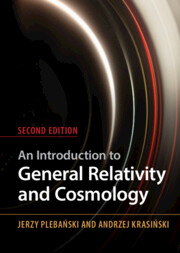Book contents
- Frontmatter
- Contents
- The scope of this text
- Preface to the second edition
- Acknowledgments
- 1 How the theory of relativity came into being (a brief historical sketch)
- Part I Elements of differential geometry
- Part II The theory of gravitation
- 12 The Einstein equations and the sources of a gravitational field
- 13 The Maxwell and Einstein–Maxwell equations and the Kaluza–Klein theory
- 14 Spherically symmetric gravitational fields of isolated objects
- 15 Relativistic hydrodynamics and thermodynamics
- 16 Relativistic cosmology I: general geometry
- 17 Relativistic cosmology II: the Robertson–Walker geometry
- 18 Relativistic cosmology III: the LemaÎtre–Tolman geometry
- 19 Relativistic cosmology IV: simple generalisations of L–T and related geometries
- 20 Relativistic cosmology V: the Szekeres geometries
- 21 The Kerr metric
- 22 Relativity enters technology: the Global Positioning System
- 23 Subjects omitted from this book
- 24 Comments to selected exercises and calculations
- References
- Index
20 - Relativistic cosmology V: the Szekeres geometries
from Part II - The theory of gravitation
Published online by Cambridge University Press: 30 May 2024
- Frontmatter
- Contents
- The scope of this text
- Preface to the second edition
- Acknowledgments
- 1 How the theory of relativity came into being (a brief historical sketch)
- Part I Elements of differential geometry
- Part II The theory of gravitation
- 12 The Einstein equations and the sources of a gravitational field
- 13 The Maxwell and Einstein–Maxwell equations and the Kaluza–Klein theory
- 14 Spherically symmetric gravitational fields of isolated objects
- 15 Relativistic hydrodynamics and thermodynamics
- 16 Relativistic cosmology I: general geometry
- 17 Relativistic cosmology II: the Robertson–Walker geometry
- 18 Relativistic cosmology III: the LemaÎtre–Tolman geometry
- 19 Relativistic cosmology IV: simple generalisations of L–T and related geometries
- 20 Relativistic cosmology V: the Szekeres geometries
- 21 The Kerr metric
- 22 Relativity enters technology: the Global Positioning System
- 23 Subjects omitted from this book
- 24 Comments to selected exercises and calculations
- References
- Index
Summary
The family of the Szekeres–Szafron, shell solutions of Einstein’s equations, is derived and discussed in detail. The discussion contains, among other things, the interpretation of the Szekeres coordinates, the invariant definitions of the whole family, the class II ($\beta,_z = 0$) family as a limit of the class I family, matching the Szekeres metric to the Schwarzschild metric (the class II S metric can be matched to Schwarzschild only inside the event horizon), conditions for absence of shell crossings, the description of the mass dipole, the apparent horizons, the Goode–Wainwright representation and a brief listing of recommended further reading on geometric and astrophysical properties of these solutions.
Keywords
- Type
- Chapter
- Information
- An Introduction to General Relativity and Cosmology , pp. 391 - 441Publisher: Cambridge University PressPrint publication year: 2024

